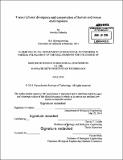Transcriptional divergence and conservation of human and mouse erythropoiesis
Author(s)
Pishesha, Novalia
DownloadFull printable version (7.238Mb)
Other Contributors
Massachusetts Institute of Technology. Department of Biological Engineering.
Advisor
Harvey F. Lodish.
Terms of use
Metadata
Show full item recordAbstract
Mouse models have been used extensively for decades and have been instrumental in improving our understanding of mammalian erythropoiesis. Nonetheless, there are several examples of variation between human and mouse erythropoiesis. We performed a comparative global gene expression study using data from morphologically identical stage-matched sorted populations of human and mouse erythroid precursors from early to late erythroblasts. Induction and repression of major transcriptional regulators of erythropoiesis, as well as major erythroid-important proteins, are largely conserved between the species. In contrast, at a global level we identified a significant extent of divergence between the species, both at comparable stages and in the transitions between stages, especially for the 500 most highly expressed genes during development. This suggests that the response of multiple developmentally regulated genes to key erythroid transcriptional regulators represents an important modification that has occurred in the course of erythroid evolution. In developing a systematic framework to understand and study conservation and divergence between human and mouse erythropoiesis, we show how mouse models can fail to mimic specific human diseases and provide predictions for translating findings from mouse models to potential therapies for human disease.
Description
Thesis: S.M., Massachusetts Institute of Technology, Department of Biological Engineering, 2014. Cataloged from PDF version of thesis. Includes bibliographical references.
Date issued
2014Department
Massachusetts Institute of Technology. Department of Biological EngineeringPublisher
Massachusetts Institute of Technology
Keywords
Biological Engineering.